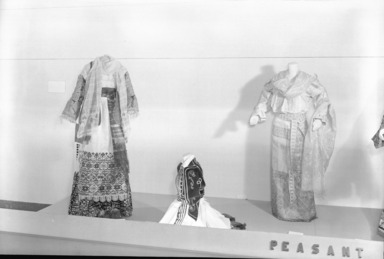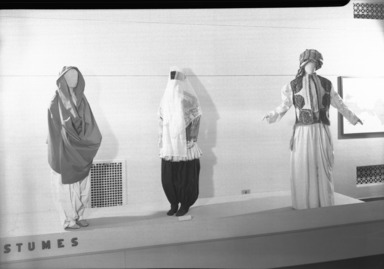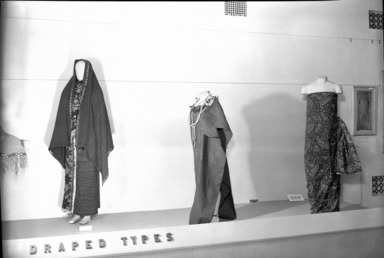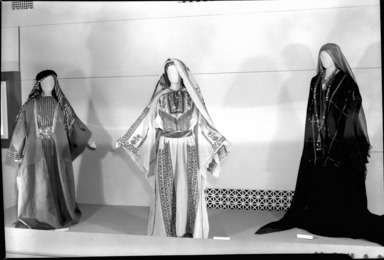

Nothing to Wear, March 15, 1940 through May 05, 1940 (Image: PHO_E1940i001.jpg Brooklyn Museum photograph, 1940)

Nothing to Wear, March 15, 1940 through May 05, 1940 (Image: PHO_E1940i002.jpg Brooklyn Museum photograph, 1940)

Nothing to Wear, March 15, 1940 through May 05, 1940 (Image: PHO_E1940i003.jpg Brooklyn Museum photograph, 1940)

Nothing to Wear, March 15, 1940 through May 05, 1940 (Image: PHO_E1940i004.jpg Brooklyn Museum photograph, 1940)

Nothing to Wear, March 15, 1940 through May 05, 1940 (Image: PHO_E1940i005.jpg Brooklyn Museum photograph, 1940)
Nothing to Wear
-
March 14, 1940
An exhibition called “Nothing to Wear, or 25,000 Years in Search of a Suitable Costume,” will be opened to the public March 15th at the Brooklyn Museum after a private preview Thursday evening, March 14th, for the Members of the Museum and their guests. It will run through Sunday, May 5th, and will be the last of the season’s large special exhibitions. Most of the material used is from the Museum’s collection. It is augmented in a few special fields by loans. The lenders to date are: The American Museum of Natural History, Brummer Galleries, Inc., The Metropolitan Museum of Art, Museum of Costume Art, Peabody Museum of Archaeology and Ethnology, Singer Sewing Machine Company, Torrington Needle Company and The Traphagen School of Fashion.
M. D. C. Crawford, Research Editor of the Fairchild Publications, has prepared a handbook, called “Philosophy In Costume”, which will be illustrated, and on sale to the public for 35 cents. Mr. Crawford contends that while “variety and change are the constant rule”, there are certain factors common to all clothing and all adornment which remain fundamentally the same through recorded time. He deals with the three main classifications of garments; the tailored, the draped, and the composite, as they have developed down the ages; and with the inventions of tools and machinery for tailoring, from the aboriginal needle to the modern mass production machines. He concludes that the craft arts and the craftsman have increased rather than diminished in value to civilization, and that collections of textiles, costumes and other objects of useful arts such as those in the Brooklyn Museum are necessary and valuable sources for researchers and designers.
As the title implies, the exhibition will trace the development of wearing apparel from the dawn of history to the present day, which means from the first records and traces of body ornament to a white lace evening gown just presented by Jay Thorpe & Co. to the Museum for its permanent fashion collection. This gown, designed especially for the purpose and to record the typical dominant fashion trend of 1939, is planned as the first of a series to be designed and presented each year. The exhibition is a natural outgrowth of the Museum’s special interest in textiles and costumes, its collections of which are outstanding in this country.
(Divisions)
The Special Exhibition Galleries off the Entrance Hall will house the bulk of the show. In the first foyer ornamentation of the body itself will be displayed; in the large principal gallery, costume development from the first recorded indications of clothing, resulting from the last glacial period, to the 18th century; next, 18th century costumes will be arranged in a foyer with furniture of the period; and last, an extensive room will trace 19th and 20th century dress development.
(1st gallery)
Body ornament, as presented in the first gallery will show that the search for beauty is thousands of years old, with ornament at first serving magical purposes. It was thought necessary to protect all openings in the body such as the nose, ears and mouth, and this resulted in the devising of objects that became earrings, necklaces and bracelets. Make-up probably had the same origin. Some ways of ornamenting the body itself were filed teeth, tattooing, cutting patterns in the skin, painting the body, shaving or adding to the hair. “Hair-dos” have always been an important part of “chic”, regardless of time, place or the cultural level of a people, and for years African natives have had permanent waves.
Some of the exhibits that will demonstrate this phase of human culture will be earrings, nose sticks, hair ornaments, necklaces, bracelets, arm bands, girdles and large pictures of primitive peoples wearing such ornaments and with their bodies painted, tattooed or scarified. One that will probably attract special attention is a preserved human head from New Zealand, with scar tattooing known as Moko, lent by the University Museum of Philadelphia.
(Main gallery)
The second phase, as presented by the exhibition, is what man did when he made his choice between freezing to death or using the skins of animals for warmth, when the catastrophe of the last glacial era crept up on him. It is surmised that he made a garment which more or loss followed his figure. No clothing remnants nor pictorial records exist, but the attempt to make skin clothing is evidenced by cutting, scraping and sewing tools. The American Museum of Natural History is lending Paleolithic scrapers, knives, a tool for cutting bones into needles and implements for drilling needle-eyes.
Eskimo bone needles, modern survivals of these objects, will be shown and costumes that are cultural descendants of the prehistoric ones. These include North American Eskimo, Siberian, Koryak and Amur River; and similar types, though not of the same material, such as Ainu of Northern Japan and Bogobo of the Philippines.
With this group the first grand division of costumes evolves, namely the "tajlored" type of dress. The other grand division, “draped” costume, made of uncut pieces of spun or woven fabrics, will be contrasted with the tailored apparel.
The development of draped clothing began in warm areas where the protective clothing was unnecessary and where the two major inventions of spinning and weaving took place. Textiles were evolved from wild and cultivated plants, such as cotton, wool, flax and grasses that could be converted into thread. The silkworm’s usefulness to man probably began at the same time. When woven the fabrics were used as they came from the loom, as early weaving peoples did not cut a textile because it would unravel. This phase will be illustrated by spindles, looms and charts explaining the major techniques. The costumes in this section will be a Hindu sari, a Javanese sarong, a Mexican woman’s draped costume, an American Plains Indian skin-draped costume, an African man’s draped-skin costume lent by the Traphagen School of Fashion, a Peruvian costume, and large representations of Egyptian costume as seen on original painted linens, and illustrations of Greek costume from statues.
When “tailoring” peoples and “draping” peoples made contact, composite clothing, the type traditional to the Near East, naturally came about. This development, accomplished by the movements of nomadic tribes such as the Scythians, is demonstrated, for example, by a Byzantine silver plate of the 3rd Century lent by the Brummer Galleries with a lion hunt scene showing a male warrior and an Amazon on horseback.
A large collection, lent by the Traphagen School of Fashion, of contemporary Near Eastern costumes, which have changed in style very little in hundreds of years, will illustrate this phase. They will comprise the costume of a Mohammedan woman, an Arabian woman from Jerusalem and a woman’s costume from Zanzibar.
Costumes of early Christian Europe followed these simple, partly tailored, partly draped lines, and aside from Oriental influence in textiles, they followed the general lines of Roman dress until the introduction of armor, all of which is brought out in the exhibition.
The effect of armor on clothing was decisive as the finest tailoring ever done was required to distribute eighty pounds of metal over the whole body to give the maximum of freedom of action and without causing undue weariness in any one portion of the body. Textiles, in turn, influenced the decoration on armor. The Metropolitan Museum is lending armor to demonstrate this.
A group of Far Eastern costumes will be shown because of their influence on the West from the time of Marco Polo and other explorers. Costumes from China, Japan and Tibet, from the Museum’s own collections will illustrate this influence. The group will also point out the effect of textiles from the Near East in producing richly ornamented cloths in the 16th century. Portraits lent by the Metropolitan Museum will reflect this manifestation, such as that of the Infanta Isabella of Spain, daughter of Philip, painted by Sanchez Coello.
Another source of rich fabrics was the Mohammedan. The Holy Wars of Islam from the 7th through the 15th century, spread their decorative arts widely, and the affect of the Turkish invasion of Southeastern Europe is still felt. This is evident now in peasant costumes from Hungary to Greece, and will be illustrated by costumes of a Hungarian man and woman and a Greek peasant woman, lent by the Traphagen School, two Romanian and Bulgarian costumes lent by the Museum of Costume Art, and other Balkan costumes from the Museum’s own collections. This completes the plan of the largest gallery.
(3rd gallery)
In the second foyer will be the lavish costumes of the 18th century, shown with 18th century furniture and accessories. There will also be displayed here examples of tape measures and yardsticks, lent by the Singer Sewing Machine Company, as well as needles and illustrations of tailoring establishments for fashionable ladies of the period.
(4th gallery)
The last room will have the most popular appeal, as it will contain costumes remembered by people of today. The major changes in the silhouette of the 19th and early 20th centuries will be traced. The transition from the straight line dress to the bell shape, familiar now through “Gone With The Wind”, will receive particular attention, as will the disappearance of the bustle during the mauve decade.
The last section shows the Gibson Girl type and the return to the straight line which is still, in the main, the silhouette of today. Technological developments which have had great influence on the production of clothing, particularly mass production, also will be presented in this section. Two of the exhibits will be one of the first sewing machines, lent by the Singer Sewing Machine Co., and complete collection of needles prepared for the exhibition by the Torrington Needle Company.
The evening gown designed by Wilson Folmar of Jay Thorpe & Co., and presented to the Museum, brings the exhibition to the latest fashion trend. This dress is of white cloque lace with slender, emphasized waistline and the “covered” look given by a long-sleeved bolero.
(Crawford remarks)
In the handbook prepared by M.D.C. Crawford, he says: “No fundamentally now idea, either in costume or in fabric, in texture, design or color combination, has been evolved in the last two hundred years, which includes the age of the machine. We are still working with the basic ideas evolved by craftsmen in different parts of the world, and at different periods in the history of the world, and brought together by the commerce of the world at various points of focus.
“A modern and adequate museum brings in one grouping many examples of the world’s speculative craftsmanship, from many peoples and many times; and it, therefore, becomes a fundamental laboratory and guide for the designers of machine products.”
Brooklyn Museum Archives. Records of the Department of Public Information. Press releases, 1939 - 1941. 01-02/1940, 043-7.
View Original -
March 9, 1940
Installation work in the special exhibition galleries of the Brooklyn Museum has been going on for over a week in preparation for one of the most ambitious exhibitions of its kind to be held in this country. It is being called “Nothing to Wear” or “25,000 Years’ Search for a Suitable Costume,” and will attempt to show the evolution of the world’s clothing from the earliest times to a modern evening gown recently presented by Jay Thorpe, Inc., who designed it especially for the Museum’s costume collection. Lacking the actual pre-historic costumes, the exhibition will show the bone needles with which they were made.
The Brooklyn Museum in particularly fitted to stage such a show because of its large and complete costume collection. A special handbook has been written for the event by Mr. M. D. C. Crawford, research editor of the Fairchild Publications.
The Exhibition will open with an invitation preview for Museum members and their guests, Thursday evening, March 14, and will open to the public the next day. It will run through May 5.
Brooklyn Museum Archives. Records of the Department of Public Information. Press releases, 1939 - 1941. 03-04/1940, 063.
View Original -
September 16, 1939
Ten exhibitions are already on the Brooklyn Museum’s exhibition schedule for the 1939-1940 season. As an opener, in order to be current with the style news, an exhibition of a more or less preliminary character opened on Saturday, September 9th, called Style Foundations--Corsets and Fashions of Yesterday and Today, to run through October 1st.
The first exhibition of the season opens on Friday, September 22nd, and will be called “Long Island in the 70’s". It will be a showing of some 160 prints of Brooklyn and Long Island scenes taken from a collection of over 2000 negatives of scenes in Long Island, Connecticut, New Jersey and the Hudson Valley, taken by George B. Brainard and acquired by the Museum twenty years ago. Only recently these negatives were brought to light by the Photographic Department. It will exhibit a cross section of the Long Island subjects and will demonstrate the character of the hundreds of records that Brainard made during his busy photographing days. Closing date is October 8th.
In memory of William A. Putnam, who made possible the Museum’s Print Room, an exhibition will be arranged to be called “The Putnam Memorial Print Exhibition” to run from October 7th through the 29th. It will consist of prints by Rembrandt, the gift of Mr. and Mrs. Putnam, and other graphic material from the Brooklyn Museum collection.
The year’s accessions will be put on view from Saturday, October 14th, through Sunday, the 29th.1 This will be followed by the first large comprehensive show of the season which will be as complete a collection as possible of masks, drawing for the most part from the Museum’s own possessions. The masks are to be shown in groups according to use. The exhibition will run from Tuesday, October 24th, to Monday, January 1st.
Following will be a watercolor exhibition which will form a memorial to both George Pearse Ennis and Paul L. Gill. This will be shown from Saturday, November 4th, through Sunday, November 26th. This is the last opening scheduled for the calendar year. After the first of the year on Wednesday, January 17th, there will be an extensive showing of the work of Eastman Johnson to run through Sunday, February 25th. Work has been under way for several months to collect examples of this painter that have not been shown before.
On February 9th an exhibition of etchings by Rodolphe Bresdin will be put on view through Sunday, March 31st.
The second large exhibition of the year will be a complete costume show, drawn, as the mask exhibition will be, principally from the Museum’s own collection. This exhibition will open on Tuesday, March 12th, and continue through Sunday, May 5th.
The last exhibition to open this season according to the present schedule will be that of Brooklyn Artists, which will be on view from Friday, April 5th, to Sunday, the 28th. From time to time there will be small special exhibitions that will take form during the season.
LIST BELOW, ABOVE INFORMATION IN TABULAR FORM
Style Foundations---Corsets and Fashions of Yesterday and Today. September 9th through October 1st.
Photographs by George B. Brainard. “Long Island in the 70s.” September 22nd through October 8th.
Putnam Memorial Print Exhibition. October 7th through October 29th.
Recent Accessions. October 14th through October 29th.
Masks, October 24th through January 1st.
George Pearse Ennis and Paul L. Gill Watercolor Exhibition. November 4th through November 26th.
Eastman Johnson Exhibition. January 17th through February 25th.
Rodolphe Bresdin Exhibition. February 9th through March 31st.
Costume Show. March 12th through May 5th.
Brooklyn Artists. April 5th through April 28th.
Brooklyn Museum Archives. Records of the Department of Public Information. Press releases, 1939 - 1941. 07-09/1939, 204-5.
View Original -
February 3, 1940
Due to its natural relationship with the Costume Show, the “Glamour Secrets of the Ancient World” exhibit, which opened February 3, is being continued for the duration of the Costume Show, through May 5.
It will be augmented by illustrated books on beauty from the library of Madame Helena Rubinstein, which contains such volumes as “Etiquette for Ladies,” 1830; “The Arts of Beauty” by Madame Lola Montez (a best seller during the latter days of her fame); “How to be Pretty though Plain” by Mrs. Humphreys, 1899, and others.
Brooklyn Museum Archives. Records of the Department of Public Information. Press releases, 1939 - 1941. 03-04/1940, 067.
View Original

